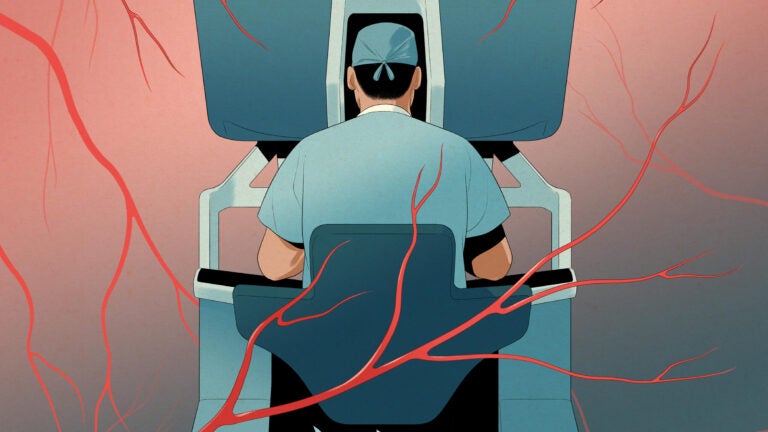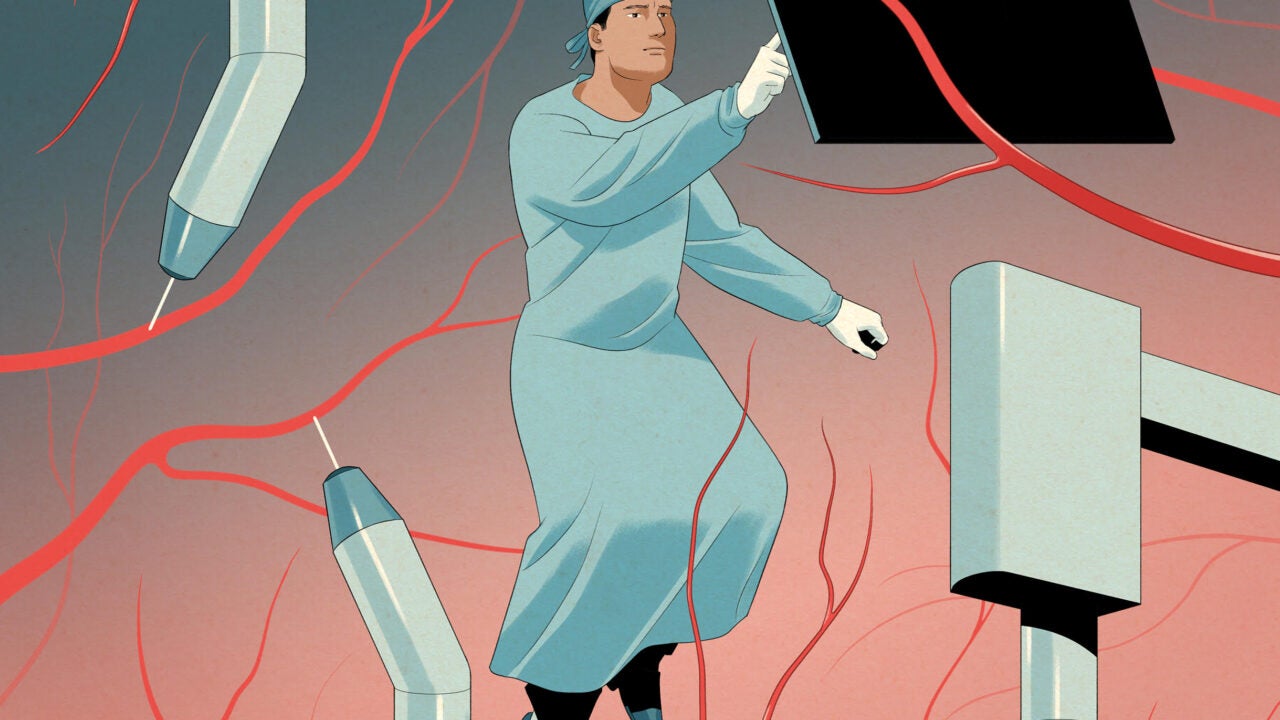
Urologist Inderbir “Indy” Gill is pioneering the world’s first bladder transplant with the aid of a robotic system called da Vinci Xi. (Illustrations by Anuj Shrestha)
Performing the world’s first bladder transplant: How a USC urologist blazed the trail
Renowned USC urologic surgeon Inderbir “Indy” Gill is on the verge of performing the world’s first human bladder transplant clinical trial. His skills in robotic surgery — and zeal for innovation — are making it possible.
In the operating room at Keck Hospital of USC, urologist Inderbir “Indy” Gill is “on the robot.”
That’s his way of saying he’s performing surgery with the aid of a robotic system called da Vinci Xi. Gill — who is chair and distinguished professor of the Catherine and Joseph Aresty Department of Urology of the Keck School of Medicine of USC, founding executive director of Keck Medicine’s USC Urology, and the Shirley and Donald Skinner Chair of Urologic Oncologic Surgery — sits at the console manipulating instruments that control the system’s four robotic arms. Each arm is outfitted with surgical tools about the size of a pencil tip that can cut and connect human tissue with greater precision than possible with larger tools held by human hands.
Gill’s field of vision is completely immersed in the console’s stereoscopic monitor. A high-definition, 3D camera beams magnified images of the patient’s abdominal tissues onto the screen.
“I’m completely inside the patient’s belly, virtually speaking,” Gill says. “I don’t see anything else around me.”
I’m completely inside the patient’s belly, virtually speaking. I don’t see anything else around me.
— Inderbir Gill
Integrating emerging technologies into his vision for advanced urological cancer procedures has made Gill a surgical pioneer. He’s one of the first and most highly regarded robotic surgeons in the field of urology, and the team he leads at USC has emerged as a world leader in robotic, minimally invasive techniques for treating kidney, bladder, prostate and testis cancer.
Now, Gill is pushing the boundaries of robotic surgery even further as his team looks to perform the world’s first human bladder transplant in an investigational research trial.
In April, after over two years of preclinical research to develop transplant techniques, Gill launched a clinical trial that will soon enroll its initial bladder transplant recipient. The research has the potential to revolutionize the way urologists treat a select subset of patients with debilitating bladder conditions and significantly enhance their quality of life.
“We’re always trying to figure out new ways to improve the current standard of care,” Gill says of his research team. “Our desire to serve our patients propels us to innovate treatments that have never been done before — and the lack of precedent does not stop us.”
Challenging the status quo
Since 1954, when the first human organ (a kidney) was successfully transplanted, transplant surgery has been primarily limited to organs critical to keeping a person alive, such as the heart, lungs, liver and kidneys.
But Gill notes that in the past 10 to 15 years, the field has expanded to include transplantation of body parts such as the face, hand, penis and uterus.
So, why hasn’t a bladder been transplanted before?
Part of the answer is that other surgical solutions for replacing a diseased bladder already exist.
Bladder removal (cystectomy) is a common treatment for invasive bladder cancer, as well as for some neurological conditions and inflammatory diseases that impair the bladder’s ability to store and empty urine. After cystectomy, the surgeon creates a new way for urine to exit the body (aka “urinary diversion”).
For decades, the gold standard for urinary diversion has been to refashion a part of the patient’s own intestine. Some patients receive what’s known as an ileal conduit, in which a piece of intestine is used to form a tube that protrudes through the side of the abdomen and directs urine to a bag worn outside the body. Others receive a “neobladder,” a bladderlike pouch made of intestinal tissue that is attached to the urethra and allows patients to urinate through the normal channel.
But Gill points to a range of complications that can ensue when surgeons connect bowel tissue, which contains bacteria, to the urinary tract, which is sterile: recurrent infections, stone disease, gradual reduction of kidney function, and electrolyte imbalances, among others. When patients lose a portion of their intestines, they may also have problems absorbing food. Forty to eighty percent of patients with intestine-built urinary diversion experience varying degrees of short- and long-term complications.
“We have accepted the morbidity and the complication rates that are associated with the use of the bowel in the urinary tract,” Gill says. “No one has thought, ‘Hey, can we do better? Are there some patients who might benefit from a bladder transplant?’ — which to us is rather stunning, that it has not been explored.”
No one has thought, ‘Are there some patients who might benefit from a bladder transplant?’ — which to us is rather stunning.
— Inderbir Gill
Until now…
Gill reasoned that although a bladder transplant would bring its own risks, it could sidestep the complications of using intestinal tissue and offer select patients a more normal bladder substitute.
As Gill and his team began to brainstorm about how to execute a bladder transplant, they had to contend with the second reason no one had previously attempted it: the surgical complexity.
Typically, when a diseased bladder is removed, the blood vessels around the patient’s bladder do not have to be preserved because the organ will no longer be used. But if Gill were to remove a healthy bladder from a deceased donor, those blood vessels would need to be preserved so they could function for the transplant recipient.
“That is orders of magnitude more technically challenging,” Gill says. “You have to go into the deep pelvis.”
Steven Shapiro, who oversees Keck Medicine of USC and the Keck School of Medicine as senior vice president for health affairs, notes that Gill came to this challenge with the skills and mindset needed to tackle it. “He’s fearless,” Shapiro says. “The bladder is a very highly vascularized [blood vessel-rich] organ. Quite frankly, it would scare most surgeons away.”
Robots to the rescue
About two years ago, Gill teamed up with his then-resident Nima Nassiri — who is now a faculty member in transplant surgery at the David Geffen School of Medicine at UCLA — to develop and test a first-of-its-kind surgical approach to bladder transplant. Their research, whose results will appear in the October 2023 issue of The Journal of Urology, involved performing bladder transplantation first on pigs, then on human cadavers, and finally on heart-beating, braindead human research donors
As anticipated, taking the bladder and its intact vessels out of the donor proved to be the most challenging part of the procedures — and this is where Gill’s facility as a robotic surgeon was crucial for success.
The team performed both open surgery (with handheld surgical tools) and robotic surgery and found the robotic approach to be superior. It allowed a more magnified view of the pelvic organs and greater ability to control potentially dangerous bleeding from the deep pelvic blood vessels.

Even with the robotic assistance, there was a steep learning curve. Typically, when Gill removes a bladder robotically for cancer treatment, it takes him only about 45 minutes. “The first bladder we removed for the transplant from the heart-beating donor took 11 hours,” Gill says. Eventually, with repeated practice and refinement, they were able to whittle the time down to four hours.
The next step was to prepare the donor bladder for transplant into the recipient, and Nassiri and Gill innovated time-saving techniques here, as well. On the surgical back table, they connected the bladder’s right and left artery to each other and right and left veins to each other, creating one artery and one vein. That meant they only had to make two connections to the recipient’s blood vessels rather than four. Gill made those vascular connections robotically with high precision.
Over a two-year period, they worked nights and weekends, in addition to their ongoing clinical and surgical duties serving patients, to perfect their techniques until they were satisfied with the results. Ultimately, transplantation proved to be a success in multiple heart-beating, brain-dead donors, with good blood flow to the new bladder as evidenced by pink, healthy tissue.
A new set of questions
When Nassiri and Gill shared the results of their preclinical research at the annual meeting of the American Urological Association in April 2023, the response from the urologic transplant community was uniformly positive. The first word out of the session moderator’s mouth was, “Wow!” Transplant surgeons in the audience came up to the microphone, and their first response was also, “Wow!” Their peers peppered Gill and Nassiri with questions, but they regarded the research as an essential, big first step.
While Gill is pleased by this initial reaction, much work lies ahead. “The research to date has raised more questions than answers,” he says.
One unknown is how the transplanted bladder, which will be attached to the recipient’s urethra, will function, given that it would be devoid of nerve connections that control its contractions.
“While it should work nicely as a storage organ, it may not expel urine as well as the normal bladder,” says Gill. That could mean that transplant recipients may need to periodically empty their bladders by manual abdominal pressure or with a catheter. However, Gill plans to leave intact the net of nerves surrounding the donor bladder, so it’s possible that new nerve connections may regrow, either spontaneously or by nerve grafting. Another option is to implant a stimulator to deliver an electric current to excite the bladder to initiate bladder contractions.
Even if a transplanted bladder becomes a seamless replacement for the patient’s own bladder, Gill cautions that applications of the treatment will be limited initially. “At the end of the day, any transplant is done only for extreme scenarios,” Gill says. “No transplant is done where the organ is working, let’s say, 50%. It is done only when it’s down to near zero.”
Another limiting factor is that any patient who receives an organ transplant needs to take immunosuppressive drugs (which suppress the immune system) to decrease the chances of organ rejection. These drugs also interfere with the immune system’s role in fighting cancer, which means most patients with active cancers would not be good candidates for a bladder transplant — unless they were already taking immunosuppressive drugs for another health issue.
Despite these limitations, Gill is optimistic that well-selected individuals could experience life-changing benefits from bladder transplantation. He points to patients with nervous system injury to the bladder and those with chronic inflammatory bladder disease as possible examples. These conditions can cause debilitating shrinkage of the bladder, diminishing its storage capacity
“Such patients are going to the restroom 10 to 20 times during the day and also at night, and/or have severe pelvic pain,” Gill says. “And medications have failed. Basically, their life revolves around this, and it can drive one to desperation. Whether bladder transplantation in such folks would be viable remains to be seen. But at least from a conceptual perspective, it’s appealing.”
Making history
The next step in the process — to transplant a bladder into a living human patient for the first time — depends upon finding the right candidate and donor availability. Gill anticipates they should find a match within the next three to six months. He hopes to enroll 10 patients in this first clinical trial. Already, he has received inquiries from patients and their providers around the world who are interested in participating.
Shapiro isn’t surprised that Gill’s research has attracted attention from the national and international medical community. “It really is just an exemplar of what great clinical care we do [at Keck Medicine of USC] and how we do it in an academic way to bring new therapies to life,” he says.
It’s precisely that spirit of innovation that keeps Gill and his team motivated to push forward.
If there’s an opportunity to introduce a groundbreaking treatment to the world, “then you got us where we live,” Gill says. “Making possible what once seemed impossible is our beating heart.”



